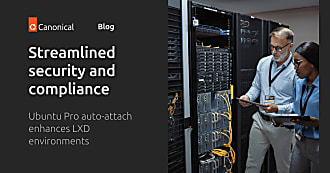Miona Aleksic
on 15 February 2024
5 Edge Computing Examples You Should Know

In the fast-paced world of technology, innovation is the key to staying ahead of the curve. As businesses strive for efficiency, speed, and real-time data processing, the spotlight is increasingly turning towards edge computing.
Edge computing represents a paradigm shift in the way data is processed and analysed. Unlike traditional cloud computing, which centralises data processing in distant data centres, edge computing brings the processing power closer to the source of data. This not only reduces latency but also opens up a world of possibilities for industries across the board.
In this blog, we’re excited to explore examples of this cutting-edge technology, with its diverse applications and use cases, with a special focus on how Canonical’s MicroCloud fits seamlessly into this transformative landscape.
Edge computing examples across industries
- Smart cities and urban planning
Edge computing plays a pivotal role in the development of smart cities. By deploying edge devices such as sensors and cameras throughout urban environments, data can be processed locally to optimise traffic management, enhance public safety, and improve overall city infrastructure. Real-time analytics at the edge enable swift decision-making, leading to more efficient and responsive urban systems.
- Healthcare and remote patient monitoring
The healthcare sector is leveraging edge computing to enhance patient care and streamline medical processes. Edge devices in healthcare facilities enable real-time monitoring of patients, ensuring timely intervention and reducing the need for extensive data transfer to centralised servers. In remote areas, edge computing facilitates telemedicine, providing access to healthcare services for those in underserved communities.
- Industrial IoT for predictive maintenance
Edge computing is revolutionising industrial operations by enabling predictive maintenance through the Internet of Things (IoT). In manufacturing environments, sensors attached to machinery collect and analyse data locally. This allows for early detection of potential issues, minimising downtime and optimising maintenance schedules. The result is increased efficiency, reduced costs, and improved overall equipment effectiveness.
- Autonomous vehicles and enhanced safety
The automotive industry is embracing edge computing to power autonomous vehicles and enhance road safety. Edge devices onboard vehicles process data from numerous sensors, cameras, and lidar in real-time, enabling quick decision-making without relying on distant cloud servers. This low-latency approach is critical for the success and safety of autonomous driving systems.
- Retail and personalised customer experiences
Edge computing transforms the retail experience by enabling personalised services and improving customer engagement. In-store cameras and sensors analyse customer behaviour, allowing retailers to offer targeted promotions and optimise inventory management. This real-time data processing at the edge enhances customer satisfaction and creates a more seamless shopping experience.
MicroCloud: a tailored solution for edge computing
In the dynamic landscape of edge computing, choosing the right solution is paramount. Canonical’s MicroCloud emerges as an ideal edge cloud solution, seamlessly aligning with the diverse edge computing examples presented. Offering a compact and efficient cloud infrastructure, MicroCloud is designed to deliver edge computing capabilities with a focus on simplicity, scalability, and reliability.
Key Features of MicroCloud
Compact Form Factor: MicroCloud’s compact form factor makes it suitable for deployment in diverse environments, from industrial settings to urban landscapes, ensuring that edge computing resources are readily available where they are needed the most.
Scalability: MicroCloud allows for easy scalability, accommodating the varying demands of edge computing applications. Whether it’s in a smart city deployment or an industrial automation setting, MicroCloud can scale to meet the evolving needs of the edge.
Reliability and Security: With a robust architecture, MicroCloud ensures the reliability and security of edge computing operations. Its design aligns with the stringent data security requirements of industries such as healthcare and telecommunications, providing a trustworthy foundation for critical applications.
A consolidated snapshot of key edge computing examples and trends
To delve deeper into the world of edge computing and its dynamic use cases, read more in our whitepaper, “Edge computing use cases across industries”. This whitepaper explores real-world examples, industry-specific applications, and the potential impact of edge computing on businesses and society.
As we navigate the ever-evolving technological landscape, understanding the practical applications of edge computing is crucial for businesses aiming to stay ahead. This whitepaper serves as a valuable resource for those seeking to harness the power of edge computing and unlock new possibilities in their respective industries.
Further reading
Learn more about Canonical’s open source infrastructure solutions.
How a real-time kernel reduces latency in telco edge clouds
Adopting open-source Industrial IoT software
CTO’s guide to MicroCloud: Learn how to build your Edge strategy with MicroCloud



